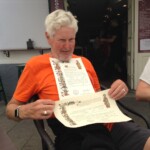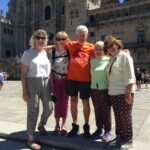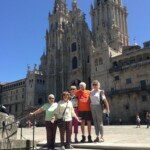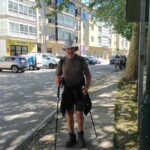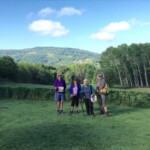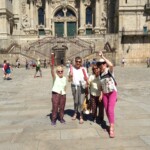The Way of Saint James or Camino de Santiago de Compostela refers to various pilgrim walks leading to the Cathedral of Santiago de Compostela (Cathedral of St James of The Field of Stars) in the province of Galicia in north west Spain, where tradition has it that the remains of the saint are buried. Many follow its routes as a form of spiritual path or retreat for their spiritual growth. It is also popular with hiking and cycling enthusiasts.
The main pilgrimage route to Santiago follows an earlier Roman trade route which continues to the Atlantic coast of Galicia, ending at Cape Finisterre (literally the end of the World or Land’s End in Latin).The earliest records of visits paid to the shrine dedicated to St James at Santiago de Compostela date from the 9th century. The pilgrimage to the shrine became the most renowned medieval pilgrimage, and it became customary for those who returned from Compostela to carry back with them a Galician scallop shell becoming the badge of a pilgrim. The scallop shell is now the symbol of the Camino de Santiago, and is seen very frequently along the trails marking the route. The earliest recorded pilgrims from beyond the Pyrenees visited the shrine in the middle of the 11th century, but it was not until a century later that large numbers of pilgrims from abroad were regularly journeying there. During the Middle Ages the route was highly travelled, however, the Black Death, the Protestant Reformation, and political unrest in the 16th century Europe led to its decline. By the 1980s only a few hundred pilgrims per year registered in the pilgrim’s office in Santiago.
In October 1987 the route was declared the first European Cultural Route by the Council of Europe. It was also named one of UNESCO’s World heritage Sites. Since the 1980s the route has attracted a growing number of modern-day international pilgrims. Now, more than 300,000 pilgrims arrive in Santiago each year and receive their Compostela certificate. Many more walk different sections of the routes which begin in various parts of the Iberian Peninsula and all over Europe.
One has to travel for religious/spiritual reasons in order to receive the Compostela. However, if you walk the Camino for cultural or non-religious/non-spiritual reasons, you can receive a certificate of welcome. The pilgrim passport (credential) needs to be stamped at least once a day; or twice a day if you are starting your Camino in Galicia. The most famous Camino route is the Camino Francés or French Way starting in St Jean Pied de Port, in the French Pyrenees. The trail from St Jean Pied de Port to Santiago is 800kms long and takes approximately four to five weeks to complete but you can start your Camino at any point.
To receive your Compostela certificate you need to walk at least 100kms into Santiago This makes Sarria (111kms away from Santiago) the most popular starting point for walkers. This was the chosen starting point for four intrepid Westhill Walkers, Carolyn Ainsbury, Geraldine Davey, Liz McKenzie and Liz Penny on 24 May 2019. Even more daunting for many pilgrims, the starting point of St Jean Pied de Port, 800km away in the French Pyrenees, was the starting point of another two intrepid Westhill Walkers, Kathleen Scanlan and Bob Donald with a departure date one month earlier on 26 April 2019. Bob was doing the walk to raise money for the charity Maggies Aberdeen Centre,
The sincere wish and expectation that both groups would meet up to complete the final leg to Santiago Cathedral came to fruition on 30 May 2019. Unfortunately Kathleen Scanlan did not finish the French Camino on this occasion, having left the final section of this route from Leon for another time.
Having completed the full 800km, Bob has raised an impressive £3182-50 for Maggie’s. Westhill Walkers would like to congratulate Bob for completing such an epic walk and for raising so much for such a good cause. We would also like to congratulate, Carolyn, Geraldine and the two Liz’s on completing the last 100km of the route and receiving their certificate.


